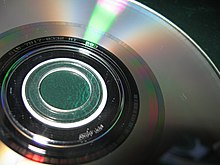
Back GD-ROM Catalan GigaDisk Danish GD-ROM German GD-ROM Spanish GD-ROM Finnish GD-ROM French GD-ROM Hungarian GD-ROM ID GD-ROM Italian GD-ROM Japanese
 | |
 The underside of a GD-ROM disc | |
| Media type | Optical disc |
|---|---|
| Capacity | 1.2 GB[1] |
| Developed by | Yamaha |
| Usage | |
| Optical discs |
|---|
GD-ROM (an abbreviation of "Gigabyte Disc Read-Only Memory") is a proprietary optical disc format originally used for the Dreamcast video game console, as well as its arcade counterpart, the Sega NAOMI and select Triforce arcade board titles. It was developed by Yamaha to curb piracy common to standard CDs and to offer increased storage capacity without the expense of the fledgling DVD-ROM. It is similar to the standard CD-ROM except that the pits on the disc are packed more closely together, resulting in a higher storage capacity of 1 gigabyte,[1] a 30% increase over a conventional CD's capacity of 700 megabytes.
The Dreamcast ended up being the only sixth-generation console with a disc based on CD technology rather than DVD technology; even the Nintendo GameCube's smaller 8 cm (3") discs held 20% more data due to being based on DVD technology. In addition, GD-ROM proved to be an ineffective anti-piracy measure when it was discovered the Dreamcast's forgotten MIL-CD functionality could be exploited to boot games burned to CD albeit with some content removed.
After the discontinuation of the Dreamcast worldwide on March 31, 2001, Sega continued to use the GD-ROM format in arcades with the Sega NAOMI 2, Triforce and Sega Chihiro. With the release of the Sega Lindbergh in 2005, Sega moved on to DVD discs and continued to use satellite and internet technology in the arcade. The last disc-based Naomi 2 and Triforce games were released in 2006 which marked the final releases using the GD-ROM format.
© MMXXIII Rich X Search. We shall prevail. All rights reserved. Rich X Search